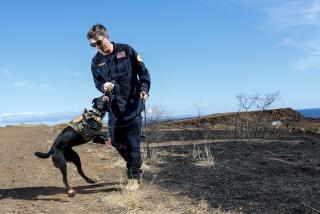Get the Ball! But First, Scat!
- Share via
KENMORE, Wash. — Deep in the woods, Gator is learning to find wolverine scat. Since there aren’t any wolverines within a couple of hundred miles, samples are planted in the brush.
The 8-year-old blue heeler has an educated nose. The former drug-sniffing dog can find marijuana, heroin and cocaine. Now he tracks poop from grizzly and black bear, cougar, jaguar and maned wolf in Brazil, fisher, bobcat, lynx and wolverine.
University of Washington biologist Sam Wasser figures Gator can help determine if the wolverine found recently in north-central Washington is the only one there.
“Find it!” says handler Heath Smith, turning him loose.
Gator charges down the trail and zeros in on the first sample. He sits and looks back at Smith, his handler and best pal: Score!
Smith tosses him a tennis ball.
Most of the dogs in the program are rescued from the pound, said Wasser, who developed the program as director of the University of Washington’s Center for Conservation Biology.
At the shelters, he or one of the handlers bounce a tennis ball. The dogs whose heads bob up and down, tracking the ball, make the first cut.
“If they stop to pee and drop the ball, then they’re out because they’re not obsessed enough with the ball,” he said.
Breed is not an issue. “All dogs have good noses,” Wasser said. “Anything that has a high ball drive is what you want.”
Busy Gator finds all four samples. If there were feces from any of the other species he’s mastered, he’d find them too. Anything to get the ball.
So once the dog finds it, what good is a pile of animal scat?
Wasser, who holds the university’s endowed chair in conservation biology, has been working more than 20 years to figure that out. The answer is, plenty -- and more all the time.
Science has long used scat to determine what animals eat. Now, with advances in DNA and other technology, feces provide information about nutrition, reproduction, disease and stress. The keys are hormones and other indicators, such as DNA from intestinal cells that slough off during digestion.
It’s a noninvasive way to collect information, especially important with endangered species.
Sometimes it’s the only way. For example, a Rottweiler was trained to detect right-whale feces off the East Coast for the New England Aquarium in 2001.
“It was pretty stinky and it was bright orange,” Wasser recalled. And live whales won’t hold still for a physical.
Gator also is trained to match -- to link samples to sources.
“If 20 samples are all from the same individual, you have the dog tell you that, and then you just need one” for expensive genetic testing, Wasser said.
“This whole program ... is really aimed at maximizing the amount of information we can acquire from as large an area as possible as cheaply as possible,” he said.
Wasser’s career began with research on baboons in Tanzania, studying competition among females. That led him to a Finnish researcher who used human feces to study links among estrogen, fiber and colon cancer -- a project that increased Wasser’s awareness of the vast information in feces.
The goal is a comprehensive health panel, like the range of tests a doctor would perform on a blood draw. Results could help scientists set priorities for endangered populations, Wasser said.
Some animals are more likely than others to enter traps or to defecate in the open, which creates a sampling bias.
“Then it occurred to me that one of best ways to reduce this bias would be doing something analogous to what they do with narcotics dogs,” Wasser said.
So in 1997 he began three years of work with Barbara Davenport with the state Corrections Department at McNeil Island, who trains virtually all the region’s narcotics dogs.
Davenport also worked with Wasser and the New England Aquarium’s Roz Rolland on the right-whale project.
“That was the dry run that showed us this could work on killer whales,” said Wasser, who plans a trial in the San Juan Islands this summer with a dog trained to find orca scat.
Longtime whale researcher Ken Balcomb at the Center for Whale Research in Friday Harbor said he had agreed to give Wasser’s scat dogs a try.
“If Sam is successful with these dogs ... we’d have a lot more information about diet and hormones and stuff,” Balcomb said. “Some of it’s kind of magic and wishy, but we don’t want to pooh-pooh him.”
More to Read
Sign up for Essential California
The most important California stories and recommendations in your inbox every morning.
You may occasionally receive promotional content from the Los Angeles Times.













